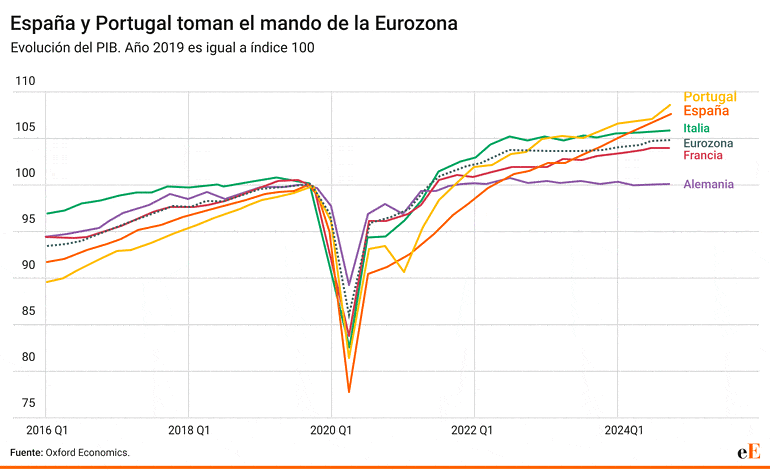But economists warn it’s not enough, on its own, to avoid recession
Spanish newspaper El Economista has described the “Iberian miracle” which has saved Europe from recession… so far.
With the economies of France and Germany in the doldrums, Spain and Portugal were responsible for 50% of the eurozone’s growth in the last quarter.
It’s a surprise that is intriguing economists. But according to investment bank JP Morgan, the dynamic is not sustainable: unless Germany and France start recovering, Europe is heading for recession.
“Probably never before has the Iberian Peninsula been so important in keeping the euro economy afloat”, venture reports.
Between them, Spain and Portugal account for just 13% of the eurozone’s GDP, but if the two nations were excluded from the last quarter’s analysis, the eurozone’s growth would already have dipped into negative territory. In fact, “annual growth would have halved”, says El Economista.
Spain on its own accounted for a third of all eurozone growth in the last quarter, with Portugal bringing up the rear: Spain grew by 0.8% and Portugal by 1.5%. Year-on-year, Spain grew by 3.5% and Portugal by 2.7%.
On an annual basis, the boost is even clearer: The eurozone grew by 0.9%. Of that 0.9%, Spain and Portugal account for 0.43 percentage points: Spain contributed 0.3815 and Portugal 0.0459 points.
Both countries are going through a cycle of expansion in their economies, with notable demographic growth, job creation and taking advantage of new consumer preferences worldwide, which favour mass-produced services from both Spain and Portugal.
Proof of this is the unemployment rate, which in both economies is showing a clear downward trend, despite the growth in population – especially foreigners.
This means that the Iberian Peninsula is growing fast enough, as is the demand for the goods and services they produce, to absorb a large number of workers.
In the case of Portugal, the unemployment rate is 6.4%, while in Spain it stands at 10.61% – a rate which at first glance seems high, but which by Spanish standards is ‘dangerously’ low, explain economists, as it is well below the non-inflationary unemployment rate.
Thus the two southern European countries – once part of the euro’s greatest problem (remember the terrible time of the PIGS) – have “now become the horses pulling a very heavy cart, carried by the declining ‘giants’ of Germany, France and Italy”.
The recovery of these giants is essential if the euro economy is to grow in a sustainable and diversified way, El Economista points out: reiterating that growth is highly concentrated in two countries that account for so little of the eurozone economy.
JP Morgan also echoes this anomaly, especially in the case of Spain (which, due to its size, is more relevant to the eurozone’s aggregate GDP): what could happen in the future if Spain starts to lose momentum?
“Spain alone can only do so much, given its size in the eurozone. And there are significant downside risks if key countries – Germany, France – perform even worse than we have already anticipated in our forecasts, with the possible impact of a second Trump term a relevant concern,” adds the investment bank.
Reasons for the miracle
Much has been said about the reasons for this remarkable growth in Spain and Portugal. Both economies are service-orientated, and therefore less exposed to the current weakness of manufacturing in the rest of the eurozone. Both have large tourism sectors and have been important beneficiaries of the post-pandemic recovery in international travel, while net migration flows have increased, fuelling strong demographic growth.
Another reason lies in the common Iberian energy market, with its large share of renewables and low dependence on Russian gas. This has mitigated the rise in energy costs. The so-called Iberian exception also helped during the peak of the energy crisis.
Obviously, there are differences between the two countries: increased consumption and investment have been the driving forces in Portugal, while Spain has relied more on public spending and net exports.
The big question now is whether the momentum that these factors have enabled so far will continue – and everything suggests that it will.
“We expect 2025 to be another strong year for the Spanish and Portuguese economies, consolidating the Iberian Peninsula’s position as a clear leader in a struggling eurozone economy,” predicts Ricardo Amaro, an economist at Oxford Economics, in a recent report on the strong performance of both countries.
The strong growth in income and the expected recovery in the application of the PRR – the EU’s Recovery and Resilience programme – further reinforce optimism for 2025 and beyond, says Amaro.
Oxford Economics estimates that the disposable income of Spanish households will have risen by 5% in 2024, in real terms, for the second year running. Income growth was even stronger in Portugal: 7%.
“The existence of a large savings reserve, improved confidence and lower interest rates will support consumer prospects on both sides of the Iberian Peninsula,” Amaro concludes.
Another point on which Oxford Economics is optimistic is the fact that Spain and Portugal have reduced some long-standing macro-financial vulnerabilities over the last decade. The large current account deficits that were typical in the 2000s have now turned into surpluses.
“Not only the boom in tourism exports, but also other exports that have shown remarkable dynamism during this period, including some higher value-added services, such as information and technology, and technical activities”, he concedes.
Spain and Portugal are expected to continue to grow above the euro area average in the coming years. In a report published in September, AXA IM considered it “likely that Spain will continue to record stellar results in 2025”. But agrees, “if Germany, France and Italy don’t start contributing to the eurozone’s GDP, a recession is only a matter of time”.
Source material: El Economista/ ZAP aeiou

























